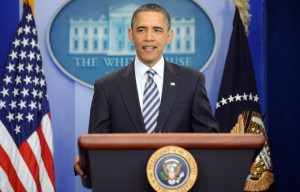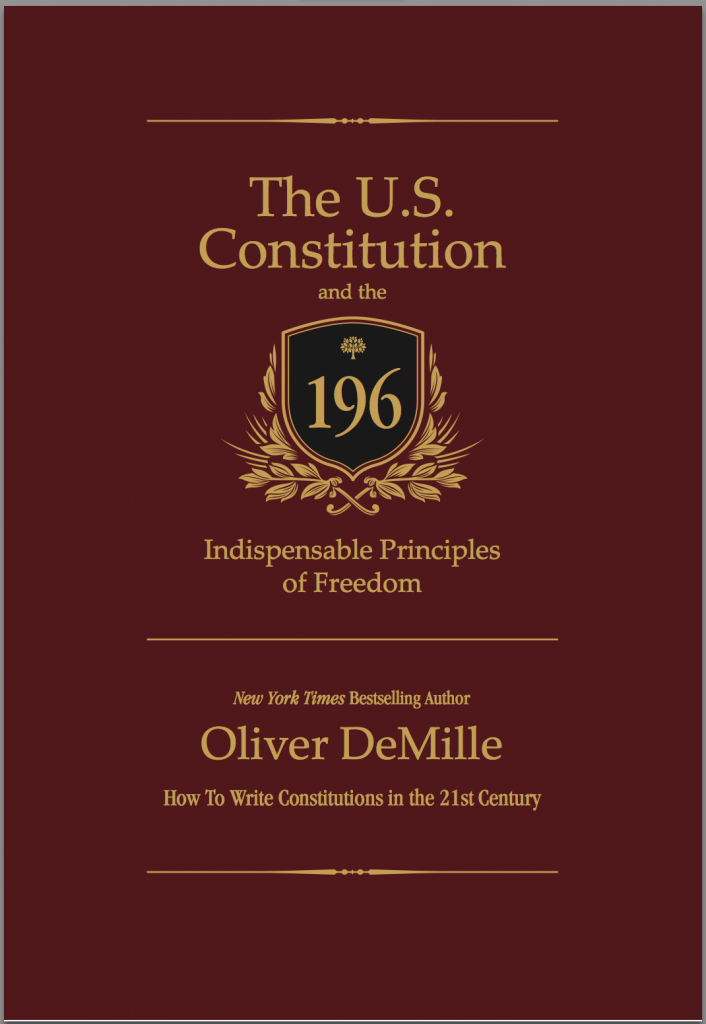The Media is Wrong About America’s Election “Anger” Problem
January 20th, 2016 // 7:52 am @ Oliver DeMille
The New Myth
 Something significant has occurred during the 2015-2016 election cycle. The mainstream media has effectively portrayed “anger” or “being politically angry” as bad. “Good” citizens, in this context, are those who aren’t upset, frustrated, or angry about…well…anything.
Something significant has occurred during the 2015-2016 election cycle. The mainstream media has effectively portrayed “anger” or “being politically angry” as bad. “Good” citizens, in this context, are those who aren’t upset, frustrated, or angry about…well…anything.
Indeed, the media has created an interesting picture of what politics should be (in their opinion). This is multifaceted, but actually quite simple. With careful camera shots, and a clear agenda in the editing room, the media has portrayed two Americas–both of them far from accurate.
On the one hand, Donald Trump, Ted Cruz, Chris Christie, and Carly Fiorina have become the faces of American anger. When the media shows clips of these candidates, they are animated, usually upset about something, and speaking in strident tones with extreme words.
Their supporters are portrayed in nearly all of the video images as rowdy, unthinking, and a bit star-struck. The clips are carefully selected to show middle- and lower-class-looking Americans waving flags, wearing campaign t-shirts, and sporting sweats, jeans, un-manicured hair and waistlines that are larger-than-normal (at least on television).
In contrast, Bernie Sanders is portrayed as an apostle of decorum. Like other candidates, he waves his arms, speaks in extreme terms, and jabs his finger repeatedly at the crowd—but this is nearly always aired without actual audio. We often don’t hear what Sanders is saying; instead a reporter or commentator uses moderate tones while these pictures run in the background.
We are left with the soft, soothing and studied commentaries of professional journalists, while Sanders’ visual antics communicate energy, passion, and political strength. The juxtaposition of these cues and messages is subtle, but effective: “Sanders has great passion and momentum, and his ideas are credible and intelligent.”
Behind the Curtain
When we are allowed to actually hear Sanders speak, he is usually sitting in a one-on-one interview, conversational, and politely direct. No finger-jabbing, no waving arms. His hair may be a throwback to an episode of Back to the Future, but he looks confidently and humbly into the camera and speaks like an economics professor. “He is just the messenger. Hear his truth…”
Most clips of his audiences emphasize trim, handsome, young people (many of them students), often with jackets and ties. Indeed, they are exact replicas of Ron Paul crowds from past elections. The older participants mostly look like academics… Once again, the message is clear.
In contrast: When Trump or Cruz are interviewed in person, the cameras invade their personal space and close in on the face. Every “angry” wrinkle is visible. The camera backs off for Sanders and Clinton, showing the whole body—dressed for an episode of Mr. Smith Goes to Washington. The message is obvious: “This is a genuine man, or woman, of the people.” Clips of their intellectual discourses-of-the-day are played and replayed. As for Trump and Cruz, the sound bites are sensational and extreme.
But watch the full videos, where they are available. In reality, all four of these candidates have moments of extremism and other moments of intellectual depth. The same is true of Christie, Fiorina, Carson, and O’Malley, for that matter. Yet ask most TV viewers, and the word “intellectual” will apply to the Democratic candidates, while the Republican candidates are “extreme.”
A lot of artful and conscientious camerawork reinforces these stereotypes.
To be clear: Sanders’ stump speeches are every bit as “angry” as Trump’s. His rhetoric is patently extreme. “Wall street is ruining it for everyone else. Greed controls our nation. The 1 percent must pay their fair share, including free college for everyone. A much higher minimum wage is absolutely necessary—anyone who disagrees is part of the lies and greed.”
Likewise, Cruz is every bit as intellectual and studied as Hillary.
Anger Management
Perhaps the most interesting thing in all this: The typical ways the mainstream media portrays the Democrats are also applied to Marco Rubio. Not to Huckabee or Rand Paul. Not to Santorum or Kasich. Not to Christie or Carson. Just to Rubio.
The media has so far portrayed him as intellectual, credible, wise—like the Democratic candidates. Also, Rubio doesn’t wear the typical Republican uniform (suits and ties that scream “Mr. Smith Owns Washington.”). He frequently wears a sweater-like casual jacket with a zipper down the front. Very pedestrian. Very academic. Again, the mainstream media frequently portrays him like it does the Democratic candidates.
Fascinating.
[Why is that, do you suppose?]
By the way, the same thing occurred with John McCain during the 2007-2008 primaries. Later, once he was the nominee, the media shifted its approach and portrayed him the same way it had other Republican: extreme, out of touch, slick around the edges, uncaring, silver platter.
Romney didn’t get this stylized media treatment in 2012, and no other Republican is getting it now. Just McCain and Rubio. Interesting…
And, again, the real message of the 2016 election, if you accept the cues and innuendos of the mainstream media, is that:
- “Anger is bad!”
and
- “The Republicans are all angry.”
Let’s consider this idea seriously. If anger is bad for politics, then we must of course be happy with everything President Obama has done. “No anger. Just smile. It’s all good.”
Steps to Solutions
The problem is that it isn’t all good. In his last State of the Union address, the President painted a rosy picture of a more prosperous and safer American than when he took office. Both are false. The national debt has ballooned from $10 trillion when he entered the White House to $19 trillion today. ISIS is a real threat, along with Al-Qaeda, the Taliban, other terrorists, North Korea, Iran (much worse than before), China, Russia…etc. We aren’t a bit safer.
There is much to be concerned about—very concerned. Calling such concern “anger” and equating it with being unintelligent or uninformed is, in fact, totally out of touch. It’s also ignorant. False. And insulting.
The economy is still facing serious problems, and the last seven years have only made things worse. Are many voters “angry?” Yes, in both parties. And with good reason.
A smug, arrogant media isn’t helping. Let’s be honest. The mainstream media are at least as responsible for today’s widespread American “anger” as the White House.
Anger isn’t the ultimate solution, to be sure. But it actually is a reasonable first step. Or, perhaps, the second step, after first recognizing that something has gone wrong. There’s a lot to be angry about, and only people who aren’t paying attention—or actually like the status quo—feel great about the country’s current path.
Determination and Change
Being angry about the bad directions Washington is taking doesn’t mean voters are unintelligent, uninformed, or unsophisticated. It means they care. It means they’re watching, and they expect Washington to do its job—a lot better than it has recently.
It means they’re still part of a democratic republic and they still believe democracy works. They take their citizenship seriously, and they’re gearing up to take action on election night.
The truth is that this is what scares the mainstream media. They label it “angry” because they don’t want to admit that the majority of voters disagree with the elite media and want a lot more government “of the people, by the people, and for the people.”
If you’re an elitist, freedom scares you. So you call it names, like “angry” or “uninformed.” In truth, it is angry, but it’s actually very well informed. It’s the power of the people focused on an election with an intensity not seen in a lot of years.
The people want real change, like they did in 2010 and 2014. And they’re determined to make it happen. But this time, their intensity is pointed at a presidential election.
The mainstream media knows what’s coming, but they’re going to try to stop it if they can. This approach will make a lot of voters even angrier—and even more determined.
**************************************
Click on a title for offer details:
Homeschooling for Dads Bundle $45 – just $18 with coupon DADSROCK-15
How to Mentor 7-Week Course
(name your price! Really!)
The U.S. Constitution and the 196 Indispensable Principles of Freedom DEEP DISCOUNT!
The Leadership Education Manifesto DEEP DISCOUNT!
The Freedom Bundle
DEEP DISCOUNT!
Category : Blog &Citizenship &Community &Culture &Current Events &Education &Featured &Generations &Government &History &Independents &Information Age &Leadership &Liberty &Politics
A Real State of the Union
January 7th, 2016 // 9:09 am @ Oliver DeMille
Where America Is Right Now
Whatever the President says in the State of the Union address early next week, here’s what really needs to be said.
A Real State of the Union:
 Sometimes things just don’t add up. They don’t make sense. There’s no way to reconcile them with…well, reality. They are square pegs in a world of round holes.
Sometimes things just don’t add up. They don’t make sense. There’s no way to reconcile them with…well, reality. They are square pegs in a world of round holes.
I recently came across five such troubling facts and questions in current events, and, to make them even more ridiculous, they’re all coming from basically the same place: The current White House.
So here they are. I’ll give a little commentary on them, but not much. They’re pretty self-explanatory. Or, maybe a better way to say this is that they’re all amazingly ridiculous and commentary won’t help.
1. According to the bipartisan Congressional Budget Office, Obamacare (the Affordable Health Care Act) will reduce the number of full-time workers in the U.S. by 2 million over the next ten years.
Seriously?
Yes.
Just think of it: That’s 2 million full-time jobs that are going to be lost simply (and specifically) because of Obamacare.
This begs the question: “Then why do we keep it?”
The next three items come from an unattributed note circulating on social media. I think they’re worth reading:
2. “We are advised to NOT judge all Muslims by the actions of a few lunatics, but we are encouraged to judge ALL gun owners by the actions of few lunatics.”
The White House couldn’t be more inconsistent on these two issues.
(By the way, I side with not judging any group by the actions a few bad apples.)
3. “Why are we cutting benefits for our veterans, no pay raises for our military and reducing the size of our army (too expensive to maintain), but we are not stopping payments or benefits to illegal aliens, or cutting federal aid to foreign countries?”
Cut the foreign aid and massive welfare (across the board, not just to immigrants) and rebuild our security.
4. “Seems we constantly hear about how Social Security is going to run out of money. But we never hear about welfare or food stamps running out of money? What’s interesting is the first group ‘worked for’ their money, but the second didn’t.”
Did government use the money paid for the first group to cover the second?
The last one is just plain jaw dropping:
5. Over the course of many months our President and the White House have repeatedly assured us of two things: (A) ISIS, Al-Qaeda, and Islamic terrorists aren’t much of a threat, and (B) the most pressing priority for our national security is to get more nations to sign environmental treaties.
Talk about fiddling while Rome burns…
The Real Concerns
Together these five amazing attitudes give us a pretty good indication of how our current national leadership is thinking.
What about terrorism? What about the struggling economy? What about the massive over-regulation of business? What about the huge amounts of capital and jobs that are fleeing to other nations? What about serious unemployment (hidden because of the way Washington calculates its statistics)? What about China, Iran, and Putin? What about North Korea, and Syria? What about our skyrocketing national debt? What about…
“Don’t worry,” we’re told. “It’s under control.”
Really?
Where?
Certainly not here in the real world. The truth is that these things are far from “under control.”
I’m an optimist, and I still believe that America’s best years are ahead. But we need to make some major changes—and fast.
Category : Blog &Citizenship &Community &Constitution &Culture &Current Events &Featured &Foreign Affairs &Generations &Government &History &Independents &Leadership &Liberty &Politics
Comparing Tax Plans from Presidential Candidates
December 8th, 2015 // 7:51 am @ Oliver DeMille
Need to Know
 This is going to be a bit wonky. Comparing tax plans of various candidates isn’t something most people do just for fun. But it’s important because a candidate’s tax plan says a lot about how the person is picturing himself/herself in the White House, and how he/she approaches fiscal and economic issues.
This is going to be a bit wonky. Comparing tax plans of various candidates isn’t something most people do just for fun. But it’s important because a candidate’s tax plan says a lot about how the person is picturing himself/herself in the White House, and how he/she approaches fiscal and economic issues.
This is vital knowledge for voters. Next to how the next president will deal with national security, knowing how he’ll approach finances is the most important thing voters can know.
The top proposals can be separated into three main categories: Little Changes, Big Changes, and Major Changes.
Little Changes
Jeb Bush
Bush promotes at least two very good ideas in his tax plan:
- Repeal Obamacare and replace it with an expanded Health Insurance Account and insurance market where policy rates stop skyrocketing, and policies are portable across state lines (further decreasing rates over time).
- Provide tax credits to people without employer-provided insurance coverage.
Bush’s plan cuts taxes from the current top rate of 39.6% down to a top rate of 28%, and a corporate rate of 20%. This is a little change, an improvement. But consider the other plans below.
Big Changes
Marco Rubio
Rubio released a plan that is similar to the Bush plan in many ways, including repealing and replacing Obamacare (like nearly all the other plans), with the top tax rate cut from 39.6% down to 35%, and the corporate rate down to 25%. Rubio promotes a number of cuts to government programs and closed tax loopholes, with an overall cut of around $11.6 trillion of taxes over time.
Rubio’s rates are higher than Bush’s, but he actually makes a bigger total cut to taxes because he provides fewer loopholes. Rubio’s plan gives a huge boost to low income families, as does Cruz, and also Trump (Trump proposes a zero tax rate for couples making up to $50,000.)
Rand Paul
Paul, as you might expect, proposes a 14.5% flat tax for everyone. The idea is to expand the tax base, while lowering all rates in ways that will stimulate business, jobs, and more capital flowing into the United States. This model also stimulates increased freedom and entrepreneurship by simplifying the tax code and collections process. Paul also wants to significantly reduce the size and cost of government.
Ben Carson
Carson provides another alternative for significant change, promoting a 15% flat tax (he wanted 10%, but decided that 15% was needed). This is similar to Paul’s proposed tax rate, but it is unclear what Carson would cut in order to balance the budget. Carson doesn’t want to outline a full plan right now, preferring to wait until elected and negotiate the costs of government down in real time. This leaves his specifics a bit hazy, but his principles on taxation are clear: lower taxes, and reduce the size of government.
Ted Cruz
Cruz proposes a 10% flat tax for individuals income, and a 16% tax business flat rate, which will most likely be a VAT (value-added tax), meaning that businesses will pass it on. This will drastically improve business investment, jobs, and economic stimulus in the U.S. economy—but it also increases consumer prices across the board. Of course, like the other plans, Cruz includes repealing Obamacare, cutting certain loopholes, and aggressively scaling back the size of the U.S. government. The Cruz plan has been criticized because it gives a major tax break to upper income families, but it is second only to Rubio’s plan in giving tax relief to the bottom 10% of households.
Major Changes
Donald Trump
Trump released a plan that includes:
- A simplification of the tax code (from seven tax rates to three, and all of them at lower rates). Compared to the flat tax, this plan ensures that high income businesses and people will pay at higher rates than the working class—but pay less than they would in other advanced nations (and less than they were under President Obama). This incentivizes major money flow to the U.S. economy, businesses, and jobs.
- A significant reduction of taxes for most Americans. For example, Trump’s plan provides a zero tax rate for a person making up to $25,000 a year (or $50,000 per year for a couple). It brings the highest earner rate of 39.6% down to 25% for a person earning over $150,000 ($300,000 for a married couple), and brings similar cut for households earning between $50,000 and $300,000 a year. This is an immediate raise and economic boost for most American workers, families, and businesses.
- An elimination of the estate tax and the marriage penalty, providing a huge financial benefit to families and small businesses.
- A reduction of corporate tax rates (from 35% down to 15%) to below those of China and other major economic competitors. This is long overdue, and like the Paul, Carson, or Cruz plans, would bring a lot of businesses (and jobs) to the U.S., and boost the American economy.
- A one-time, low-rate repatriation plan that encourages companies to bring their trillions of dollars held in foreign banks back to the U.S. economy (and keep these funds here long term). Again, this will spur a major jobs and investment increase in our economy.
- Overall tax cuts of close to $12 trillion over time. (By comparison, the Bush and Cruz plans each cut approximately $3.7 trillion over time.)
- Trump’s plan gives by far the biggest tax relief to the middle class (while Rubio helps the bottom 10% the most, and Cruz’s plan is best for the very top earners).
Carly Fiorina
Fiorina takes an even stronger approach to changing tax policy than Trump, Cruz, Carson, or Paul. She proposes a 3-page tax plan, and an overhaul of the way the government budgets, not just what rates of taxes are applied. Under her plan, every government agency and program would start at a budget of $0, and would be required to make the case for how good their programs are, how well they work, and how much money they need to keep flourishing—or improve.
Based on an outline of all such government programs, the administration would decide to keep or cut any agency or other government program, and to fund it only to the extent that it is worth the cost—when compared with all other government operations and the real needs of the nation.
Once such a budget is outlined, the tax needs and rates would be determined. This would very quickly balance the budget, Fiorina proposes, and immediately cut or downsize government programs that aren’t needed or simply aren’t working.
The Roadblock
Whatever candidate(s) you like, or don’t like, this quick overview can help us get a sense for what kind of fiscal leader the candidate might be.
Note that all of them, even the Bush plan, are significantly better than the Clinton or Sanders plans (which raise taxes and add numerous government programs). At least the leading Republican candidates seek tax reductions and the downsizing of Washington–some more than others.
Regardless of who replaces Barack Obama in the White House, some of the key points in the Trump, Cruz, and Fiorina tax plans are downright excellent. The United States needs them, and the sooner, the better. Ideas from the Bush, Rubio, Paul, and Carson plans also have merit. Some of the plans from other candidates have important policy ideas as well (research, for example, the balanced budget plan by John Kasich).
Whoever we elect in 2016 should promote the best parts of these plans and help rekindle our struggling economy.
But this brings us to a significant roadblock. No matter what tax and budget plan the next president wants to follow, the White House will have to get it through Congress. On the one hand, Congress is accustomed to budgeting a certain way and is often resistant to major new ways of doing things—regardless of what candidates promised during their campaign. On the other hand, the right kind of executive leadership could certainly make a difference in getting Congress to act.
Consider Fiorina’s proposal to give the president power to move money around to different agencies and programs—taking from those that aren’t working or aren’t really needed, and giving those funds to programs that are very effective and highly important. In many ways, this is an excellent idea.
But it has one major flaw: every time a new party enters the White House, the president could just shift a ton of money from, say, the military to environmental programs, etc.
This is a significant downgrade of the Constitutional format. On the other hand, if we combine Fiorina’s zero-budgeting program where each agency starts from zero and the president proposes major cuts, and then Congress does its own zero-based budgeting, it’s a real winner. We need this. But we need it in the Constitutional way (which seems to be what Fiorina is proposing, after all).
Ultimately, none of these plans are going to sail through Congress unscathed. Nor should they. The Constitution works, when we follow it. Checks and balances are a good thing. (Note that other plans beyond taxes, like Trump’s promise to deport all illegal aliens, would undoubtedly face serious blocks in the courts.)
But the candidates’ tax plans do give us some excellent ideas on how to slow and stop Washington’s overreach. The next president should study them and adopt a number of things contained in these plans—the best of each.
Correction, 12/12/15: A previous version of this article stated that Ted Cruz’s tax plan included a 16% sales tax. This language has been clarified to read: “… a 16% tax business flat rate, which will most likely be a VAT (value-added tax), meaning that businesses will pass it on.” Thanks to the couple of readers who questioned this detail so I could revise for accuracy.
Category : Aristocracy &Blog &Citizenship &Community &Culture &Current Events &Featured &Government &Leadership &Liberty &Politics
Understanding Obama (What is the President Thinking?)
November 23rd, 2015 // 6:02 am @ Oliver DeMille
Confusion and Concerns
 In the last couple of weeks I’ve heard the words “baffling,” “ridiculous,” “out of touch,” “unhinged,” and “I just don’t understand what he could possibly be thinking”—all directed at President Obama’s response to the tragedies in France and Mali. “It’s just like his answer to people shooting police officers,” many people are thinking, “His tone is all wrong. He thinks the good guys are the bad guys, and that the bad guys are the good guys.”
In the last couple of weeks I’ve heard the words “baffling,” “ridiculous,” “out of touch,” “unhinged,” and “I just don’t understand what he could possibly be thinking”—all directed at President Obama’s response to the tragedies in France and Mali. “It’s just like his answer to people shooting police officers,” many people are thinking, “His tone is all wrong. He thinks the good guys are the bad guys, and that the bad guys are the good guys.”
Actually, that’s exactly right. It’s a little more complicated than that, however. It boils down this: for seven years many pundits have been saying that President Obama is a centrist and a pragmatist, a Democratic centrist, yes, but not part of the far Left. But he’s acting like he is part of the far Left, now more than ever.
For example, if President Obama is a member of the far Left, this would easily explain his responses to the French massacre. The far Left tends to see the world as broken into two groups: the Oppressors and the Oppressed. Also, in this view, the Oppressors typically look and act a certain way: they hold positions of institutional power, they dress in expensive clothes, and they tend to talk for a living. Moreover, the Oppressors generally promote more power for themselves and others like them—and less for everyone else.
As president, a person with this view of the world (a place made up of Oppressors vs. Oppressed, always battling each other), is going to struggle when it comes to terrorism. Specifically: where most Americans see terrorists as the bad guys, the far Left sees people on Wall Street, big banks, the Right, K Street, Madison Avenue, and big business as the bad guys.
Likewise, where many Americans tend to see a police shooting (in, say, Ferguson, or Baltimore) as law enforcement officers protecting the Oppressed, the far Left sees it exactly the opposite—the police as tools of middle- and upper-class Oppressors, using their power to hurt the Oppressed under-classes.
The far Left tends to see terrorists as the Oppressed just looking for a way to get out from under the controls and dominating systems put upon them by Oppressive rich nations and their banks, rules, borders, etc. In this view, these things keep the poor poorer, and allow the rich to get richer.
It’s a matter of cultural dissonance. The two sides simply see the world very differently. In fact, many people see some of the elites as the bad guys. But the far Left takes it to an extreme: everyone is either helping the Oppression, often by mere inaction, or actively fighting against it.
The Divide
This isn’t anything new, of course. It’s been around for centuries. Greek, Roman and European history is full of this disconnect. It shows up in Biblical history and in ancient Egypt and Babylon. But what would be new, and different, is a president in the White House who generally sees things from the far Left viewpoint.
Such a president would see terrorism, and he would know it is wrong. He would say so. But he would also see in terrorism a fight of the Oppressed against their Oppressors, and he would view them as people trying to overcome the plight of the Oppressed.
Such a president would be willing to fight against terrorism, even sending troops and drones. But when he saw Republican rhetoric against refugees, or immigrants, would he view people who speak this way as the bad guys or the good guys? Clearly, he would think Republicans are the Oppressors, not the good guys.
Thus he would be able to stand in a press conference and unemotionally talk about the misdeeds of the terrorists in France, and only seem to get really emotional, really upset, when the topic turns to Republicans or reporters who question his motives. The Republicans and media seem like the bad guys, because they seem like Oppressors.
They would appear to be everything the far Left teaches about Oppressors—smug, educated, sure of their own righteousness, wealthy, powerful—while many of the terrorists fall into the category the far Left describes as desperate, misguided people seeking to throw off Oppression.
Where most people see terrorism as pure evil, a president with a far Left view would believe: The terrorists have the right goals (to overcome oppression), but use the wrong methods (terrorism). In contrast, the same president would believe that the Republicans and media have the wrong goals and the wrong methods, even though their methods are less extreme.
And, from the far Left view, the efforts of conservatives, bankers, middle class voters, media pundits and other Oppressors are downright wrong—and they must be stopped. Not violently, but stopped nonetheless. As a result, those on the far Left stop the terrorists because it is their duty, but they gleefully want to stop the middle class and elite “Oppressors” because they represent what in the far Left’s opinion is really, truly wrong with the world.
This view would also show up when a far Left president was speaking about police shootings. He/she would be seldom on the side of the police, often on the side of the non-police. Oppressors vs. Oppressed. Another example would arise when such a president addressed religion: often taking the side of Muslims, seldom siding with Christians. From the far Left viewpoint, this isn’t an issue of religion at all, but rather the ideal of always siding with the Oppressed minority against the Oppressive majority.
I don’t know if this critique is an accurate portrayal of the current president. I don’t know him, so I’m left with what the media shares. But this critique certainly explains a lot of his behaviors, and many of his words. It is indicative of many on the far Left. For example, when asked who her worst enemies were, Hillary Clinton mentioned terrorists as a problem but ended up calling “Republicans” her worst enemies.
She later said it was a joke. But the fact that she and many others laughed at the joke, and found it funny, is telling. People on both sides of the political divide frequently make this mistake, thinking that other Americans are really the great enemy, when so many worse enemies are out there (e.g. terrorists, Iran, Russia, China, North Korea, etc.).
What are the Solutions?
In all this, the real issue for most Americans is one of leadership. We are a nation divided. Divided about who the good guys are, and who the bad guys really are.
A nation where the majority of people don’t assume that the police are the good guys is in deep trouble. Very deep trouble. Yet our current President has seemed to signal this very thing on numerous occasions. This is a big problem.
Perhaps just as big, if not even bigger, is the President’s inability to passionately call out terrorism and unite the nation in defeating it. His attacks on terrorism seem half-hearted. For example, during the first Gulf War the allies sent out an average of nearly 1200 bombing sorties a day. In contrast, during the anti-ISIS attacks over the past 18 months, the Obama group has sent on average 6-8 sorties a day. That’s not a typo. It’s 1200 a day, versus 6-8 day. That’s a huge difference!
In short, those on the far Left aren’t really interested in foreign issues. They are focused on reformatting America, using government to transfer more and more power, money, and influence from the “Oppressive middle and upper classes” to the “Oppressed” under classes. Foreign policy is a distraction for them. They are annoyed when foreign policy problems come up at all, and wish they would just go away. For example, the President truly seems more passionate about taking away guns from law-abiding American citizens than he is about stopping terrorists.
With that kind of fuzzy leadership, not much is going to get done. The next time we elect a president, we need to look for someone whose words are crystal clear about what’s really important. Above all, the main purpose of the national government is national defense. And the main purpose of state and local governments is protection from murder, rape, theft and other violent crimes. Stopping these things is the reason government was invented in the first place.
Perhaps part of the reason political leadership has become so fuzzy is that our elected officials are doing far too much. If they focused on excellent national defense, and true public safety, and ensured freedom for all, we’d be in a much better place. That shouldn’t be too much to ask—a simple focus on protection of life, liberty and the pursuit of happiness.
The good news is that our national problems aren’t insurmountable. But without real leadership, things just struggle and worsen. This doesn’t mean that more bombing is the only answer. There are other options. But one thing is certain: Our nation desperately needs true leadership right now.
Category : Aristocracy &Blog &Citizenship &Community &Culture &Current Events &Foreign Affairs &Generations &Government &History &Leadership &Liberty &Politics
An Update on the U.S. Economy
November 19th, 2015 // 2:28 pm @ Oliver DeMille
All in the Family
 A poll by the Pew Research Center shows that, beginning in 2014, the percentage of young women living at home or with family members is the highest since 1940. The number of young men moving home is also growing rapidly, but hasn’t quite topped the 1940 mark yet.
A poll by the Pew Research Center shows that, beginning in 2014, the percentage of young women living at home or with family members is the highest since 1940. The number of young men moving home is also growing rapidly, but hasn’t quite topped the 1940 mark yet.
A significant factor in this shift is that more and more young college graduates are unable to find jobs. Another contributor is that many of the jobs young people do find don’t pay as much as they did for twenty-somethings over the past several decades.
Beyond the college changes, high rent and higher costs of living for everyone are contributing to this change. In short, more young people are staying or moving back home.
Could this be a cyclical return to the multi-generational family households that dominated the 1930s? If so, we would expect to see more grandparents moving in with middle-age children and their families (or vice versa)—and, in fact, this is also occurring. Some eras of history—those with long economic downturns or very slow economic growth—naturally tend toward multi-generational families.
Still Sputtering
Overall, the U.S. economy is still struggling, even though the Great Recession began seven years ago, and even though Washington claims it ended four years ago. But since 2011, we’ve seen only very small growth in the U.S. economy, around 1-2% annually.
For many people, this level of growth doesn’t keep up with the annual increases in their expenses. Many families still feel like the Great Recession never ended, because they seem to be falling further behind. And while the Obama Administration touts the increased numbers of jobs in the past four years, most of these jobs pay much less, and offer fewer benefits (if any), than those so many people lost between 2008 and 2012.
In other words, the recession may technically be over—on paper—but look at the numbers more closely and the economy is still sputtering. Over ninety thousand Americans have now stopped looking for work, so the lower unemployment numbers don’t really mean that lots of jobs—or good jobs—are back.
They aren’t.
The New Economic Normal?
All in all, the Obama Administration has taken the approach that 1-2 percent annual growth for our economy—with lower-paying jobs and more people relying on increased government benefits to survive—is the new normal. The Hillary Clinton and Bernie Sanders campaigns have voiced the same sentiment.
In fact, the Democratic candidates daily make the case that government should offer many more programs (a national $15 minimum wage, free college, increased welfare funds, etc.) so people can get used to making do, even without jobs. Obamacare already did this for health care, though rising costs are causing numerous problems for those who do pay for their own health care.
In contrast, many of the Republican candidates for the 2016 election have argued that we need to get back to 4% annual growth or much, much higher. Whether any of the candidates can win in 2016, and then actually do something to significantly boost the economy, remains to be seen.
We may well be at a national crossroads. If we follow the Democratic path, we’ll increase taxes and depend more on government to help families make ends meet. And paying the bills will be increasingly difficult.
If we adopt the perspective of some Republicans that we really can reboot the economy and spur 4%, 6%, or even higher growth, we can restart the American Dream for the current and next generation. But can any of the Republican candidates actually do it? Only time will tell. At least some of them are trying.
What Actually Works
Let’s be clear. Governments don’t spur economic booms. Entrepreneurs, small businesses, and big businesses that expand and hire do. But when the government regulatory burden and tax rates are as high as they are right now, it’s going to take some government action to free up the economy and incentivize more entrepreneurs and businesses to take action toward major growth.
As for the trillions of dollars held by U.S.-based corporations abroad, the government needs to bring our tax rates down to the point that it makes sense to bring this money back home to the U.S. economy. So, yes, the free economy needs real relief from government right now.
The next election could make all the difference. We’ll either reinforce the Obama legacy and put more people into low-paying (or no) jobs and onto government benefit rolls, or we’ll reboot the economy by freeing it up and incentivizing free enterprise growth, hiring, and expansion.
These are two very clear, opposite directions, and only one of them even has the chance of benefiting American freedom and prosperity in the years ahead. Our economy is at stake.
Category : Blog &Citizenship &Community &Culture &Current Events &Economics &Education &Family &Generations &Government &History &Leadership &Liberty &Politics

















